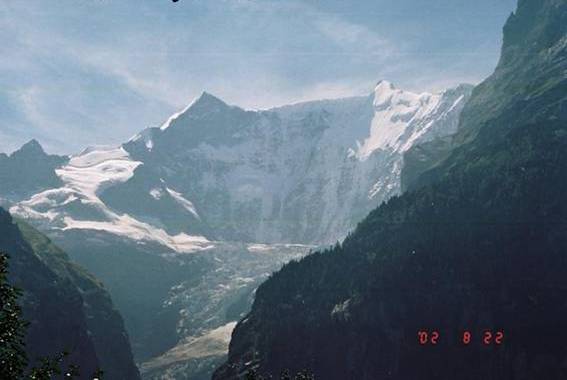90-91
106 NORTH-WEST RIDGE
AD H. Wolly
with C Jossiand H Kaufmann,
This constitutes the ordinary route from
theM6nchjoch or Bergli huts. It
achieves the grade given because of the
exposed climbing (usually on ice)
close to the summit. See also photos 60 and 61.
From the Monchjoch
or Bergli huts get onto the upper slopes of the
Ewigschneeflild.
Pass just below the foot of the S ridge of the
Walcherhorn then
slant up snow slopes to a col at the foot of the SE
ridge of this mountain (3613m, not marked).
Continue along the
ridge or just on its S side with one or two
steep (and sometimes icy)
steps, to the final section. A rock rib sits
on the crest of the ridge
and can be climbed (II, III) or it can be
turned on the L (E) side
where an exposed and frequently icy slope is
climbed back to the
crest. Follow the crest easily to the summit,
turning the last few
rocks on the R. 4-5hr
Ochs 3900m
E von Fellenberg
with P Infibnit, U and P Kaufmann,
Also known as the Klein Fiescherhorn,
the mountain has an
impressive 1300mhigh, glaciated E flank and
its N face forms the L
part of the Fiescherwand.
Quite frequently climbed by its short SW
ridge in combination with the Gr and Hinter Fiescherhorn.
107 SOUTH-WEST RIDGE
PD W Coolidge with CAlmer jun and R Almer,
60 From
the snow saddle between the Gr Fiescherhorn
and Ochs,
reached easily from the Fieschersattel
described in Route 105, climb
the snow ridge to the summit. The ridge may
be difficult because of
ice or cornices. 30min
108 NORTH RIDGE
D
61 A
worthwhile snow/ice climb in a fine setting. The ridge is reached 100m
S of Pfaffestecki
(3054m). See also photo 60
From the Schreckhorn
hut cross the Obers Ischmeer
SW then climb
diagonally up the glacier slopes above to the
col S of Pfaffestecki. If
the state of the glacier allows, before
reaching the col turn up the
slope to reach a higher col
S of Pt 3343.4m. From the lower col this
one is reached by climbing the snow and rock
crest over
Pt 3343.5m. Continue up the ridge without any
great difficulty
over snow and rock to Pt 3578m and the N edge
of a snow terrace
below and E of the summit. This point can be
reached from Route
109 by
crossing the terrace (or the climb can be abandoned here by
crossing the terrace to join Route 109). The
final steep ridge (55 degree)
is the crux and requires good technique on
ice. The ridge finishes
on the SE ridge (usually corniced) about
20mfrom the summit.
About 7hr
109 NORTH-EAST FLANK
AD+ De Villiers-Schwab,
61 This
face of the mountain has a number of rock ribs interspersed with
glacier slopes. Several routes have been
recorded but most are impractical
at present due to the crevassed state of the
glaciers. The route described is
the one most likely to be in condition. The
route can be used in descent by
parties climbing on the NW face or the N
ridge. The slope below the
siracs provides a
rapid means of descent for parties willing to run the
risk.
From the Schreckhorn
hut cross the Obers Ischmeer
SW towards
the rock buttress below Pt 2975m. Climb the
steep slope to the R of
the buttress (fairly active s6racs above)
then traverse L on the
obvious snow tongue. (It is possible to climb
on the rock buttress
via a couloir from
about half-height; the second pitch is steep but on
good holds. The way is difficult to locate in
descent.) From the end
of the snow tongue climb a broken rock ridge
easily to snow slopes
above. Climb these to a snow terrace rising R
wards below 2 rock
ribs in the face above. Follow the terrace
(some danger of sierac fall
from above) R wards
to the S side of the snow terrace below the
summit of Ochs.
From here climb the narrow, often icy, E ridge
which steepens
towards the fore-summit on the SE ridge. Continue
along the SE ridge which curves round to the
main summit (often
very difficult because of cornices). 8-9hr
P von Schumacher and
One of the great N faces of the Bernese Oberland and of the
is about 4km wide
(extending from the Walcherhorn to Ochs) and
some 1200m high, and is seamed with rock and
ice. The climbing
here has a great feeling of isolation and
seriousness. Several of the
routes have a major risk of s6rac fall and
much of the rock is poor
(but
not all). The objective dangers account for the lack of
popularity of these climbs, however a fast
party, in the right
conditions, can minimize
the risk to no more than one would find on
some of the more
crowded
position of routes
has been identified by numbering the rock ribs.
This has been abandoned as confusing, since
the various ribs are not
clearly defined.
90-91

